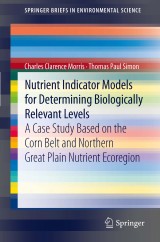Details

Nutrient Indicator Models for Determining Biologically Relevant Levels
A case study based on the Corn Belt and Northern Great Plain Nutrient EcoregionSpringerBriefs in Environmental Science
|
50,28 € |
|
| Verlag: | Springer |
| Format: | |
| Veröffentl.: | 02.04.2012 |
| ISBN/EAN: | 9789400741294 |
| Sprache: | englisch |
| Anzahl Seiten: | 67 |
Dieses eBook enthält ein Wasserzeichen.
Beschreibungen
Nutrient Indicator Models for Determining Biologically Relevant Levels: A case study based on the Corn Belt and Northern Great Plain Nutrient Ecoregion is the first book to provide answers to the management of nutrients based on changes in biological communities. The text describes a case study that is the result of a large scale project in the Corn Belt and Great Plains Nutrient Ecoregion. This study is the first to identify relationships between fish assemblages and nutrient concentrations by Nitrogen species. Species optima based on sensitivity and tolerance to nutrients is modeled. Nutrient Biotic indices calibrated for application are based on the results of years of biological indicator development. Test response intervals and Shift response intervals are formulated and validated against relevant biological assemblage shifts. This case study is the first to suggest recommended values for the nitrogen and phosphorus cycle with identifiable shifts caused in biological assemblages. This will provide watershed and environmental managers with the information needed to manage the inputs into the world’s dead zones.
1. Introduction.- 2. Methods.- 3. Results.- 4. Discussion.- 5. Conclusion.
Nutrient Indicator Models for Determining Biologically Relevant Levels: A case study based on the Corn Belt and Northern Great Plain Nutrient Ecoregion is the first book to provide answers to the management of nutrients based on changes in biological communities. The text describes a case study that is the result of a large scale project in the Corn Belt and Great Plains Nutrient Ecoregion. This study is the first to identify relationships between fish assemblages and nutrient concentrations by Nitrogen species. Species optima based on sensitvity and tolerance to nutrients is modeled. Nutrient Biotic indices calibrated for application are based on the results of years of biological indicator development. Test response intervals and Shift response intervals are formulated and validated against relevant biological assemblage shifts. This case study is the first to suggest recommended values for the nitrogen and phosphorus cycle with identifiable shifts caused in biological assemblages. This will provide watershed and environmental managers with the information needed to manage the inputs into the world’s dead zones.
Presents new perspectives on linkages between ecological health, biological indicators, and nutrient chemical concentrations Includes species optima based on parameter specific tolerance and sensitivity correlations with nutrient concentration Includes new state of the art diagnostic tools that can be used to evaluate the magnitude and extent of nutrient impacts? Includes supplementary material: sn.pub/extras
Diese Produkte könnten Sie auch interessieren:

Decision Support Systems for Risk-Based Management of Contaminated Sites

von: Antonio Marcomini, Glenn Walter Suter II, Andrea Critto

96,29 €

Dynamics of Mercury Pollution on Regional and Global Scales

von: Nicola Pirrone, Kathryn R. Mahaffey

149,79 €














